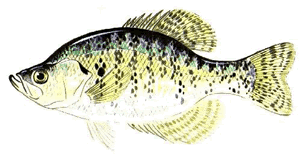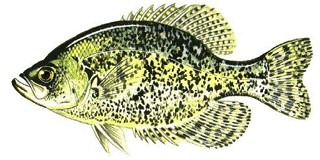Back to Previous Page
CRAPPIE
The crappie differs from the other members of the sunfish family in that they have 5 to 7 (usually 6 spines) in the anal fin and 5 to 8 spines in the dorsal fin. There are two species of crappie in Illinois: white and black. The darker colored individuals are not always males, as some people think, nor are they always the black species. The color pattern of both species is quite variable.
WHITE CRAPPIE

At-a-Glance
- Scientific Name: Pomoxis annularis
- Found in Illinois: Statewide
- State Average: 9"
- State Record: 4 lbs/7 oz (1973)
- Best Lures: minnows, jigs, spinners
Crappie strike a variety of baits and lures, however, fishing with live minnows is the most common. The best lure selection would be a jig that imitates a small minnow.
Crappies have a soft, fleshy mouth, and they are frequently referred to as "papermouths." Anglers need to be careful when setting the hook and handling crappie. Too much play or force during retrieval will tear the mouth and can result in losing the fish.
Most any type of fishing equipment can be used for crappie. It may be as simple as a cane pole or an ultra-light spinning or casting outfit. Lighter is better with crappie so anglers can detect a light or short strike. Monofilament line under 6 pound-test should be used.
Habitat: In Illinois, white crappie can be found statewide, most commonly in ponds, lakes, and bayous. Unlike the black crappie, the white crappie is more tolerant to turbid waters, where they tend to outnumber black crappie. As such, white crappie can also be found in sand- and mud-bottomed pools or backwaters of creeks.
Feeding and Habits: White crappie diets consist mostly of smaller fish (e.g., minnows), but will also feed on aquatic insects larvae, worms, and crustaceans.
Reproduction: White Crappie spawning takes place in late April and May when water temperature reaches about 56°F. The male fans out a depression with his caudal fin in 3 - 10 feet of water. Female white crappie enter the spawning area and deposit their eggs in one or more of the nests, which are immediately fertilized by the male fish. The number of eggs in a crappie nest is variable, but a nest can hold up to 20,000. It is practically impossible to distinguish the males from the females, even just before spawning.
BLACK CRAPPIE

At-a-Glance
- Scientific Name: Pomoxis nigromaculatus
- Found in Illinois: Statewide
- State Average: 8"
- State Record: 4 lbs/8 oz (1976)
- Best Lures: minnows, jigs, spinners
Crappies have a soft, fleshy mouth, and they are frequently referred to as "papermouths." Anglers need to be careful when setting the hook and handling crappie. Too much play or force during retrieval will tear the mouth and can result in losing the fish.
Most any type of fishing equipment can be used for crappie. It may be as simple as a cane pole or an ultra-light spinning or casting outfit. Lighter is better with crappie so anglers can detect a light or short strike. Monofilament line under 6 pound-test should be used.
Crappie strike a variety of baits and lures, however, fishing with live minnows is the most common. Best lure selection would be a jig that imitates a small minnow.
Habitat: Black crappie show a preference to water with a hard bottom and are common in large deep lakes. They have a high endurance to heat, cold, and foul water, which enable them to be easily transported and acclimated to new waters. In many instances, the black and white crappie are found together and hybrids may result. There is some indication that when the two species live together, one usually dominates over the other, and it is said that the white has a better chance to dominate in the South and the black in the North. Illinois observers have found that in some Illinois river bottom lakes, the white crappie were more abundant than the black for a few years and then the reverse was true.
Feeding and Habits: The diet of black crappie is similar to its cousin, the white crappie, with a diet of smaller fish, aquatic insects larvae, worms, and crustaceans.
Reproduction: Black crappie reproduction is similar to the white crappie. Spawning takes place in late April and May when water temperature reaches about 56°F. The male fans out a depression with his caudal fin in 3 - 10 feet of water. Female white crappie enter the spawning area and deposit their eggs in one or more of the nests, which are immediately fertilized by the male fish. The number of eggs in a crappie nest is variable, but a nest can hold up to 20,000. It is practically impossible to distinguish the males from the females, even just before spawning.



